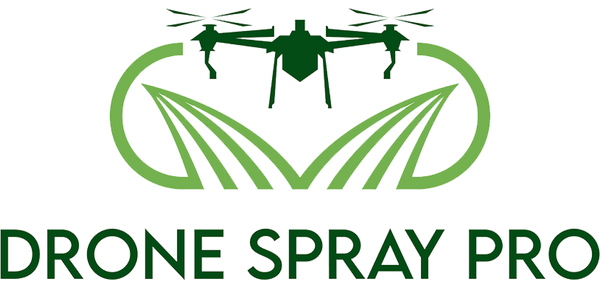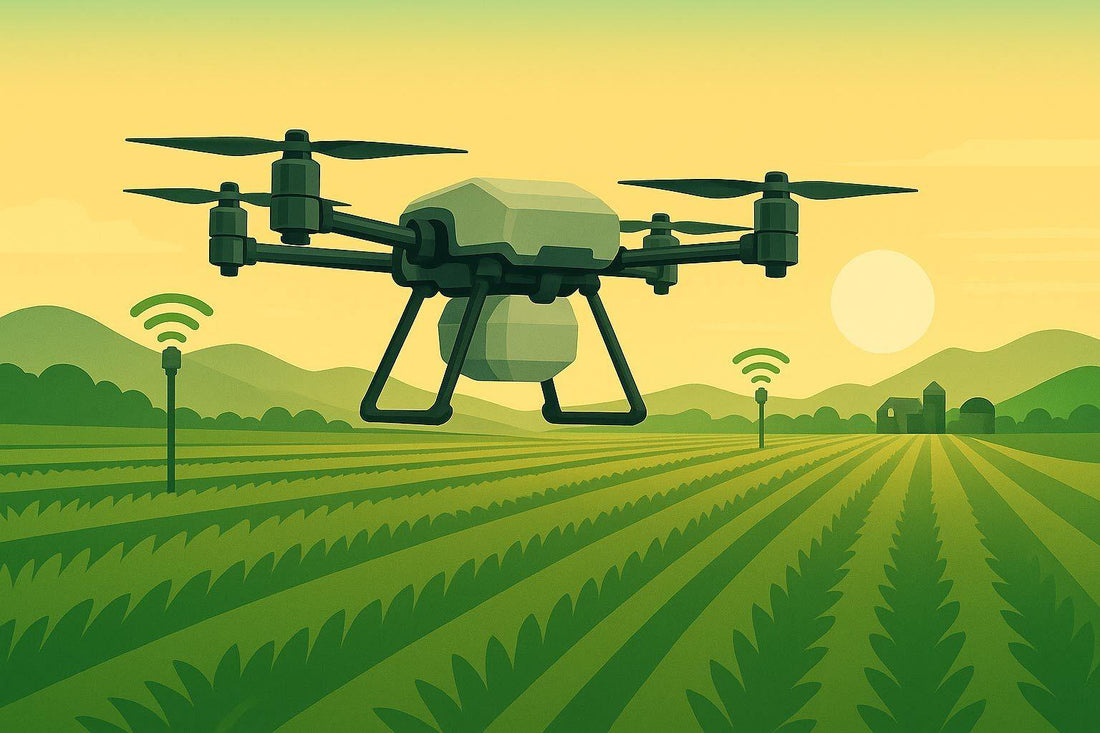
Top 6 RTK Systems for Precision Agricultural Spraying
Share
RTK (Real-Time Kinematic) technology provides centimeter-level accuracy, revolutionizing drone-based crop spraying. Unlike traditional GNSS systems (2–4m accuracy), RTK reduces chemical overlap to 0.5% and saves farmers $1,500 per farm annually. It also cuts operation time by 6% and fuel use by 6.32%, making it a key tool for efficient, cost-effective, and environmentally friendly farming.
Here are the top 6 RTK systems for precision spraying:
- Trimble Ag RTK: Centimeter-level accuracy, global Vantage™ network, and seamless integration with farm equipment.
- DJI D-RTK 2 Mobile Station: 1 cm horizontal accuracy, rugged IP65 design, and multi-drone support.
- John Deere StarFire RTK: ±1-inch accuracy, terrain compensation, and fast signal pull-in times.
- Topcon AG RTK: Ultrasonic boom control, ISOBUS compatibility, and nitrogen savings up to 20%.
- Leica Geosystems RTK: Tilt compensation, multipath reduction, and individual nozzle-level control.
- Ag Leader GPS 7500 RTK: Sub-inch accuracy, AutoSwath™ for nozzle control, and easy vehicle integration.
Quick Comparison
| RTK System | Position Accuracy | Key Features | Use Case |
|---|---|---|---|
| Trimble Ag RTK | 1–2 cm | Global Vantage™ network, real-time updates | Large farms, seamless equipment use |
| DJI D-RTK 2 | 1–3 cm | Rugged design, multi-drone support | Multi-drone spraying, tough terrain |
| John Deere RTK | ±1 inch (2.5 cm) | Terrain compensation, fast pull-in | Sloped fields, quick setup |
| Topcon AG RTK | 1–2 cm | Ultrasonic sensors, ISOBUS compatibility | Uneven terrain, nitrogen savings |
| Leica Geosystems | 1–2 cm | Tilt compensation, nozzle-level control | Detailed spraying, multipath areas |
| Ag Leader 7500 | Sub-inch | AutoSwath™, easy installation | High-speed spraying, flexible setup |
RTK systems enable accurate spraying, reduced waste, and lower costs. Choose based on your farm size, terrain, and equipment compatibility to maximize efficiency.
How to use a mapping drone to create RTK boundaries & ...
1. Trimble Ag RTK
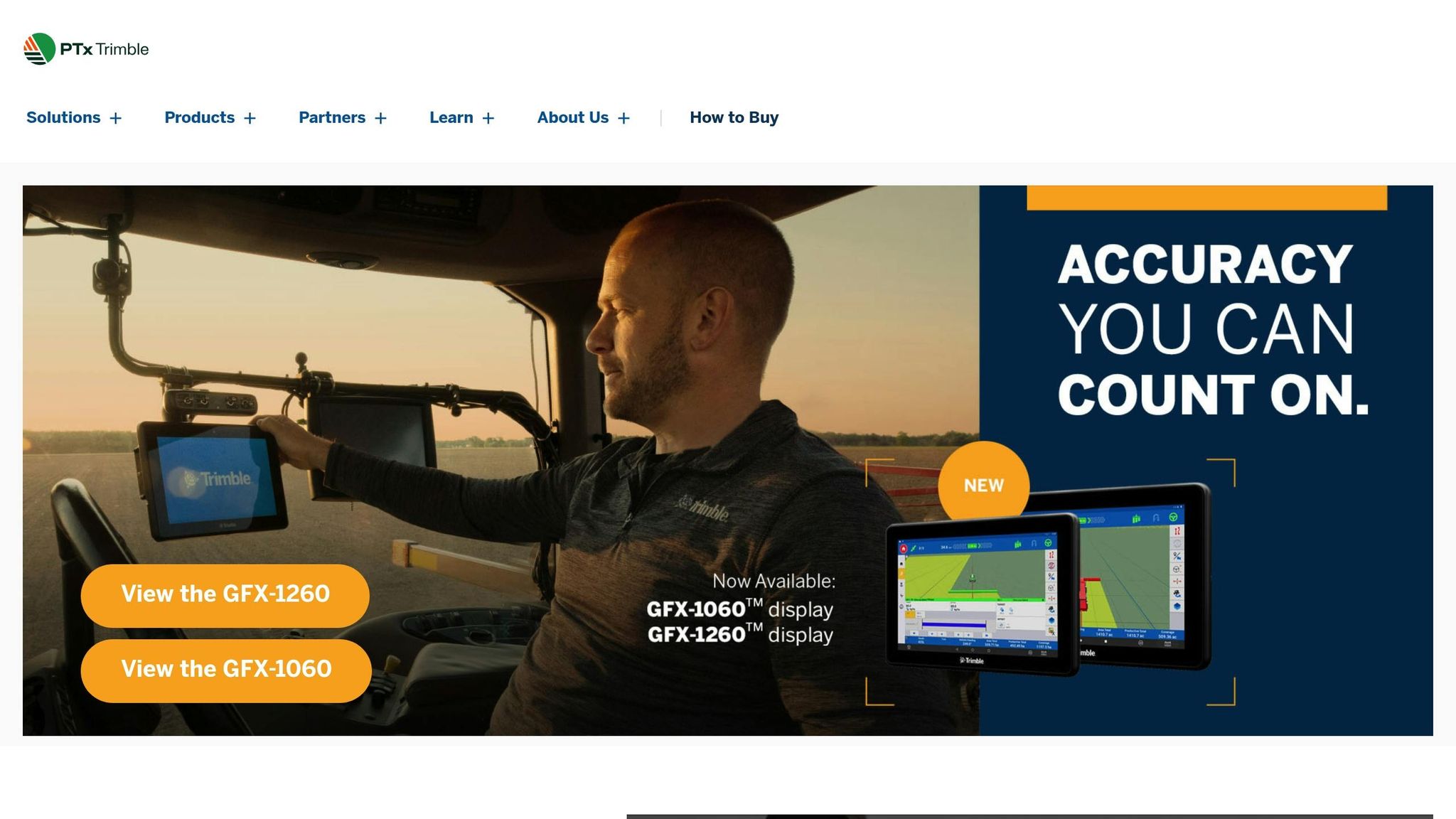
Trimble's agricultural RTK system delivers centimeter-level positioning accuracy, built on years of experience in precision agriculture. This makes it a strong choice for improving drone-based precision spraying.
With real-time correction and support from a global network of Vantage™ partners, it ensures accurate and efficient spray applications. The hardware integrates smoothly with existing farm equipment, giving farmers the flexibility to gradually upgrade their precision farming tools.
"RTK is a positioning technique that solves accuracy, motion, and timing challenges, enabling satellite positioning systems to deliver highly precise location information." – Trimble
Trimble's software tracks real-time positioning data, streamlining application control and setup. Additionally, their authorized reseller network provides on-site configuration and training throughout the United States.
2. DJI D-RTK 2 Mobile Station
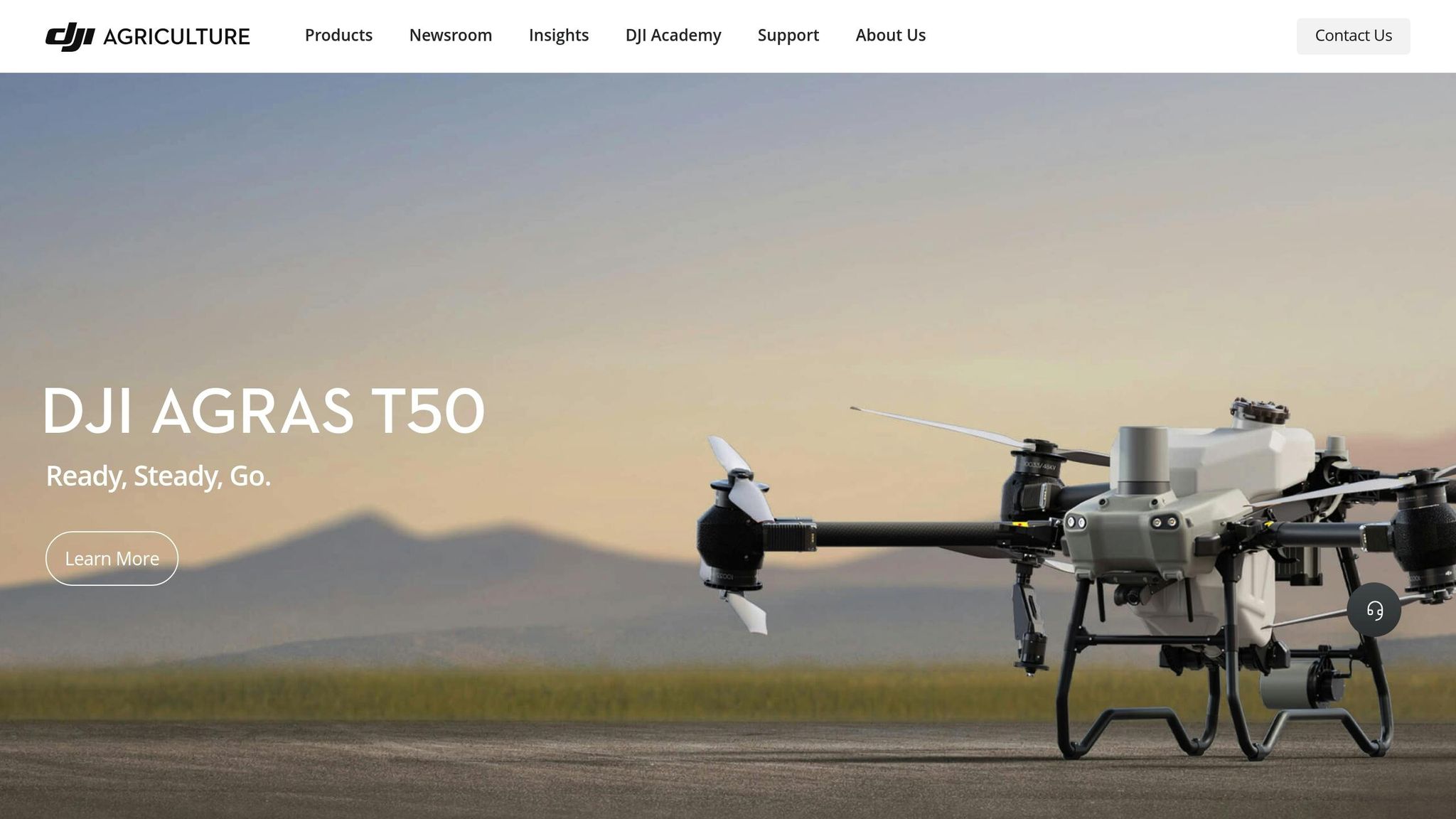
DJI offers the D-RTK 2 Mobile Station, a high-precision RTK system designed to enhance agricultural spraying operations. It provides horizontal accuracy of 1 cm + 1 ppm (RMS) and vertical accuracy of 2 cm + 1 ppm (RMS), ensuring precise positioning for efficient spraying tasks.
Built to handle tough environments, the D-RTK 2 features an IP65-rated carbon fiber body and a high-gain antenna for dependable signal reception. It supports multiple satellite systems, including GPS, GLONASS, BeiDou, and GALILEO, ensuring consistent performance across varying conditions.
| Feature | Specification |
|---|---|
| Operating Range | Up to 2 km (OcuSync) |
| Battery Life | Internal: Over 2 hours (WB37) External: Up to 50 hours (MG-12000P) |
| Storage Capacity | 16 GB |
| Initialization Reliability | Over 99.9% |
| Compatible Drones | Agras T16, T20, and other DJI agricultural models |
The station includes built-in IMUs that monitor movement and adjust tilt sensors automatically, alerting operators to potential issues before they affect spraying accuracy. This ensures consistent application rates and coverage.
For optimal performance, place the D-RTK 2 on flat ground, away from large water bodies or structures that could block signals. After powering it on, allow about 2 minutes for stable positioning.
The device supports multiple connectivity options - 4G, OcuSync, WiFi, and LAN - and can link up to 5 remote controllers, simplifying the coordination of multiple spraying drones.
3. John Deere StarFire RTK System
The John Deere StarFire 7500 RTK system is designed to deliver precise accuracy for agricultural spraying, using advanced SF-RTK technology. With a horizontal pass-to-pass accuracy of ±1 inch (2.5 cm), it achieves RTK-level precision without needing extra hardware.
This system uses four GNSS satellite constellations - GPS, GLONASS, BeiDou, and Galileo - via John Deere's StarFire network, offering double the satellite coverage compared to older models. This expanded coverage results in 73% faster pull-in times compared to the earlier SF3 systems, making field adjustments quicker and more precise.
| Feature | Specification |
|---|---|
| Pass-to-Pass Accuracy | ±1 inch (2.5 cm) |
| Long-term Repeatability | ±1 inch (2.5 cm) |
| Pull-in Time | 73% faster than SF3 |
| Satellite Systems | GPS, GLONASS, BeiDou, Galileo |
| Signal Coverage | Global StarFire Network |
| Terrain Compensation | Integrated TCM Module |
One key feature is the integrated terrain compensation module (TCM), which adjusts for roll, pitch, and yaw movements automatically. This ensures consistent accuracy, even on uneven fields or slopes, maintaining precise spraying patterns regardless of the terrain.
The system also features enhanced signal processing with a specialized choke plate that directs GNSS signals into the antenna more effectively. This design improves accuracy by 17% compared to older StarFire models with SF3 technology.
To maximize performance, the StarFire 7500 supports shared signal capability. This allows two receivers to work together, improving relative accuracy when using tools like AutoTrac Implement Guidance or Machine Sync.
"The SF-RTK signal eliminates the complexity of Radio RTK by offering similar accuracy and repeatability from satellite corrections, removing the need for additional hardware, permanent licenses, and base station access fees", according to John Deere's technical documentation.
For optimal results, ensure the system has a clear view of the sky, free from obstructions like trees or tall structures. While SF-RTK works well in most conditions, RTK Radio may still be a better option in areas with poor satellite visibility.
4. Topcon AG RTK System
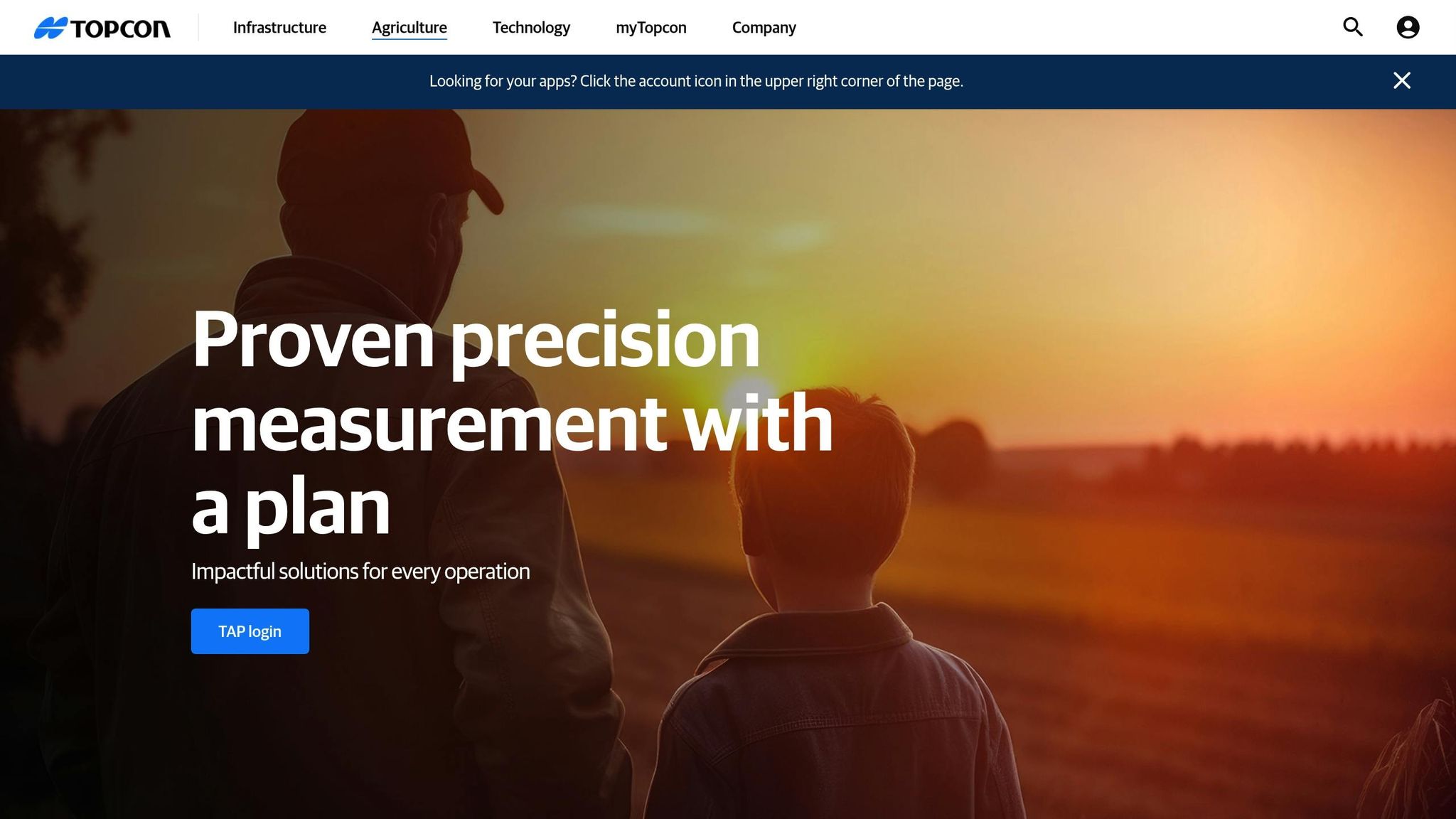
The Topcon AG RTK System delivers precise control with ultrasonic sensors that adjust boom height automatically, ensuring consistent spray distances across uneven terrain. Its ISOBUS-compliant interface works seamlessly with both self-propelled and pull-type sprayers, offering features like auto-section and variable rate controls to handle a variety of field conditions. Here's a quick overview of its key features:
| Feature | Specification |
|---|---|
| Correction Services | Local RTK base stations, Network RTK, Cellular, Satellite |
| Compatibility | Universal (ISOBUS compliant) |
| Control Options | Auto-section, Variable rate |
| Height Control | Ultrasonic sensors |
| Application Control | Pre-set height maintenance |
| Network Coverage | Broad correction network options |
The system's ISOBUS compatibility makes it easy to integrate with existing agricultural equipment. It also offers a variety of correction service options, from localized RTK base stations for pinpoint accuracy to subscription-based cellular and satellite services for broader reach, catering to diverse operational needs.
One example of its effectiveness comes from Montana, where grain producers using CropSpec Crop Canopy Sensors reported up to 20% savings on nitrogen usage. This was achieved by leveraging precise application control to maintain crop health while reducing input costs.
Additionally, the system combines spraying control with real-time crop health monitoring. This integration allows for on-the-go adjustments based on field conditions, improving spraying efficiency and reducing waste.
sbb-itb-3b7eef7
5. Leica Geosystems RTK Solution
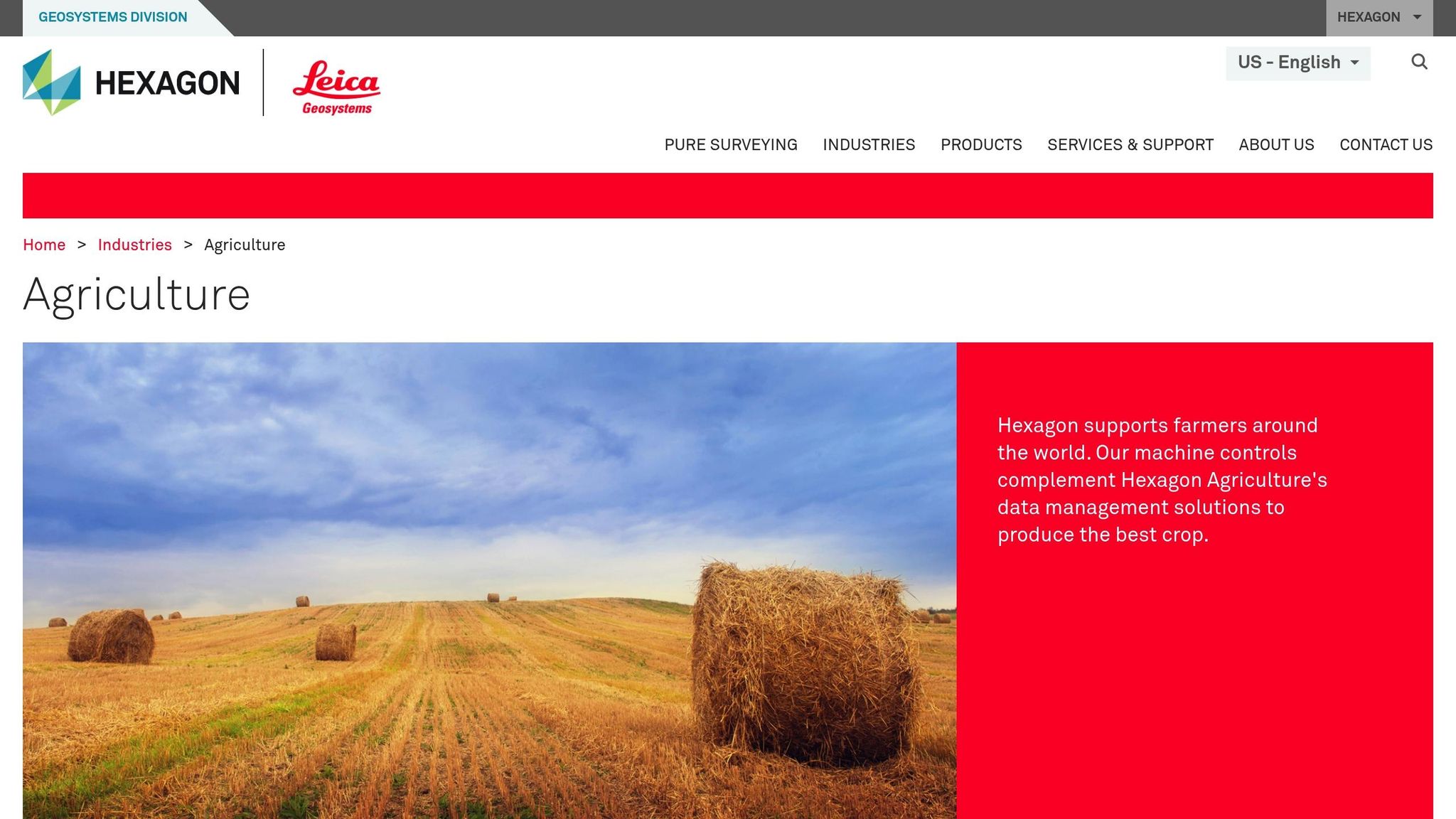
The Leica Geosystems RTK Solution, featuring the GS18 T GNSS RTK rover with tilt compensation, provides precise, calibration-free GNSS positioning for agricultural spraying - even in areas with magnetic interference. This system enhances spraying accuracy with advanced correction and control capabilities.
| Feature | Specification |
|---|---|
| Position Update Rate | 20 Hz |
| Correction Services | HxGN SmartNet Network RTK, PPP |
| Software Integration | Leica Captivate (field), Leica Infinity (office) |
| Special Features | Tilt compensation, Multipath reduction |
| Height Control | IMU-based sensor fusion |
| Application Control | Individual nozzle-level |
With HxGN SmartNet, the system achieves centimeter-level accuracy, ensuring precise variable rate spraying to reduce waste. Leica Captivate provides a user-friendly interface for fieldwork, while Leica Infinity simplifies spray planning and data management back at the office.
A farming cooperative reported that using HxGN SmartNet corrections allowed for individual nozzle-level control, significantly cutting down on chemical use and fuel consumption. In 2022, farmer Stefan Ullrich demonstrated the GS18 T's precision by coordinating machine operations during harvest, proving its reliability for complex tasks.
For detailed mapping and planning, Leica Infinity offers powerful tools to manage, process, and verify field data, ensuring efficient spray coverage and accurate application rates throughout the operation.
6. Ag Leader GPS 7500 RTK
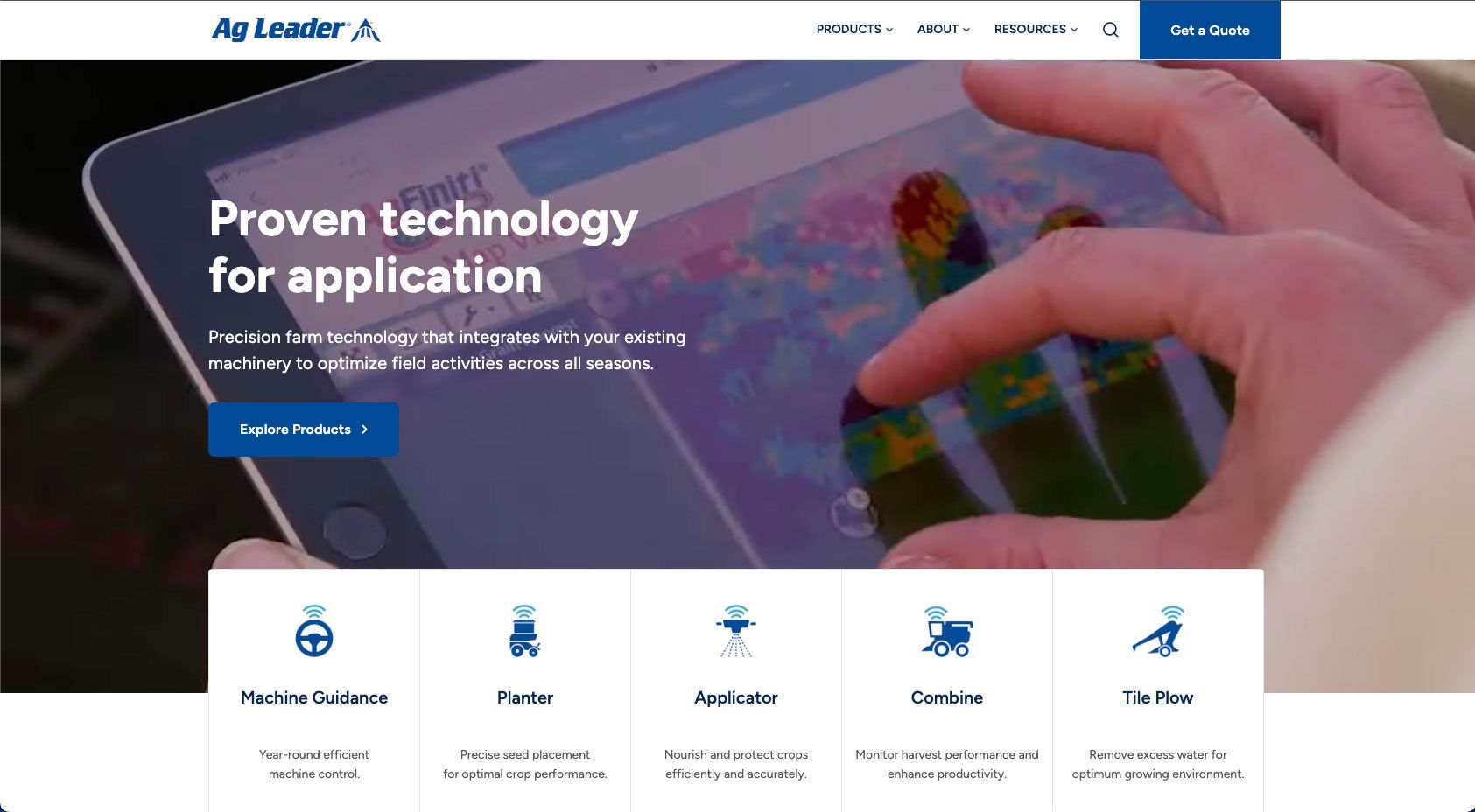 The Ag Leader GPS 7500 RTK system is a dual-frequency GNSS receiver designed for growers who require high levels of precision. It delivers sub-inch accuracy with RTK correction and supports multiple differential correction options, detailed in the table below:
The Ag Leader GPS 7500 RTK system is a dual-frequency GNSS receiver designed for growers who require high levels of precision. It delivers sub-inch accuracy with RTK correction and supports multiple differential correction options, detailed in the table below:
| Correction Type | Pass-to-Pass Accuracy |
|---|---|
| RTK | Sub-inch |
| TerraStar-X | Sub-inch (repeatable) |
| TerraStar-C Pro | Inch-level (repeatable) |
| TerraStar-L | 6 inches with 20-inch repeatability |
| WAAS/EGNOS | 8 inches |
With a 20 Hz output, the GPS 7500 ensures consistent accuracy even at high speeds, making it ideal for spraying operations. Its LED system provides real-time diagnostics, allowing users to quickly confirm system performance during use.
The GPS 7500 is built for easy integration. It features built-in magnets and a mounting plate with locating pins, making it simple to switch between vehicles without losing positioning accuracy. It’s also compatible with InCommand® displays, enabling NTRIP network RTK corrections through a single cellular connection, which simplifies the correction process.
The system includes AutoSwath™, which improves spraying efficiency by automatically controlling individual nozzles based on precise location data. Its durable smart antenna and radar speed output ensure accurate ground speed data and consistent application performance.
Additionally, integration with AgFiniti allows for smooth data transfer and remote support, providing a flexible solution to meet changing precision requirements.
Features Comparison
When it comes to positioning accuracy, RTK systems stand out by offering centimeter-level precision, which is crucial for tasks like accurate spray applications.
| RTK System | Position Accuracy |
|---|---|
| Trimble Ag RTK | 1–2 cm |
| DJI D-RTK 2 | 1–3 cm |
| John Deere StarFire | 2.5 cm |
| Topcon AG RTK | 1–2 cm |
| Leica Geosystems | 1–2 cm |
| Ag Leader GPS 7500 | Sub-inch (2.54 cm) |
The table shows that most systems consistently deliver accuracy within the 1–3 cm range. RTK technology also minimizes the need for post-processing by about 90%, allowing you to prioritize precision spraying with less hassle.
Choosing an RTK System
Picking the right RTK system for precision agricultural spraying means focusing on what your operation truly needs. If you're managing a large farm with extensive acreage, systems like the D-RTK 3 can be a great fit. It offers reliable transmissions up to 15 km, supports multiple drones with its Broadcast Mode, and stays steady even during ionospheric disturbances.
Other factors, like location and equipment compatibility, also play a big role. For farms in areas with poor network connectivity, look for systems with standalone Precise Point Positioning (PPP). These systems can deliver dependable performance even in remote areas.
Make sure the RTK system works well with your existing equipment. Different farm setups call for specific RTK features to achieve the best spraying results. Here’s a quick guide:
| Farm Type | Key Requirements | Recommended Features |
|---|---|---|
| Large Operations (1,000+ acres) | Long range, multi-drone support | Broadcast Mode, range of 15 km or more |
| Remote Locations | Standalone operation | PPP capability, multi-frequency support |
| Mixed Terrain | Stable positioning | Multi-constellation support, centimeter-level accuracy |
| Urban/Suburban Areas | Consistent signal performance | Multi-constellation support, strong positioning stability |
When it comes to software, ensure the RTK system integrates well with mapping tools. This enables precise mission planning, accurate spraying, and detailed field mapping.
For additional help, Drone Spray Pro offers expert consultation and training to help you get the most out of your equipment. By considering these factors, you can select an RTK system that matches your field conditions and technical needs.
FAQs
How does RTK technology make drone-based agricultural spraying more accurate and efficient compared to standard GPS systems?
RTK (Real-Time Kinematic) technology dramatically improves the precision and efficiency of agricultural spraying by delivering centimeter-level accuracy in real time. Unlike standard GPS systems, which can have errors of several feet, RTK corrects these inaccuracies using a network of base stations that account for factors like atmospheric interference and satellite errors.
This enhanced precision ensures that drones apply sprays exactly where they are needed, reducing waste and preventing over-application. Additionally, RTK eliminates the need for ground control points and minimizes post-processing time, making it a faster and more reliable solution for precision agriculture.
What should I consider when selecting the right RTK system for my farm and terrain?
When selecting an RTK system, focus on the level of precision required for your specific farming tasks. RTK systems are designed to deliver centimeter-level accuracy, which is essential for precise agricultural spraying and optimizing crop health.
Consider factors like compatibility with your sprayer drones, the size and layout of your farm, and the type of terrain you work with. Some systems perform better in open fields, while others are more suited for challenging landscapes with obstacles or uneven ground. Additionally, evaluate the system's ease of use and long-term reliability to ensure it meets your operational needs effectively.
By choosing the right RTK system, you can significantly improve spraying accuracy, reduce waste, and enhance overall efficiency in your farming operations.
How does integrating RTK systems with farm equipment and software improve precision farming?
Integrating RTK systems with farm equipment and software enhances precision farming by delivering highly accurate location data. This allows farmers to create detailed field maps and guide machinery with precision, improving tasks like fertilizer application, seeding, and spraying.
RTK technology also supports Variable Rate Technology (VRT), enabling resources like water, seeds, and chemicals to be applied based on specific field conditions. This not only boosts crop yields but also reduces waste and operational costs, making farming more efficient and sustainable.
